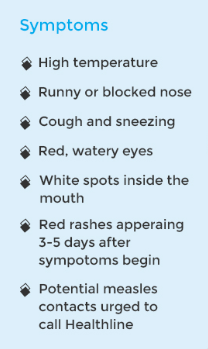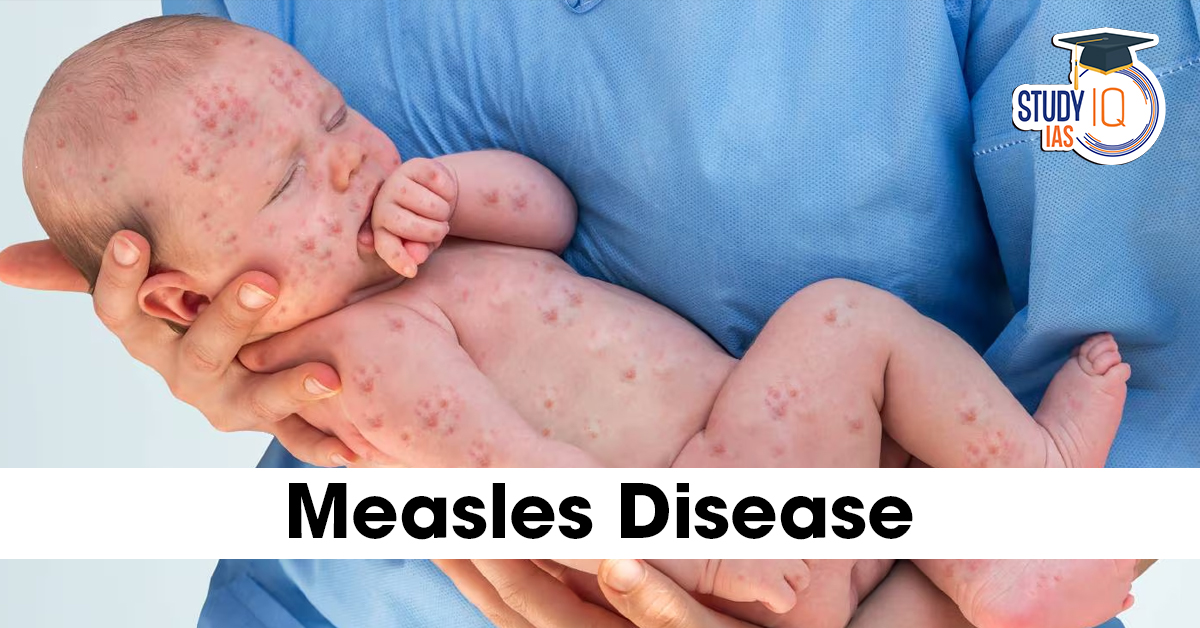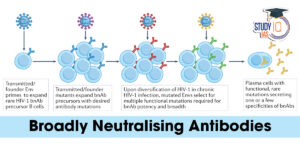Table of Contents
Context: The United States is currently facing a resurgence of Measles with 1046 confirmed cases.
About Measles Disease
Measles is caused by the measles virus (genus Morbillivirus), transmitted via respiratory droplets and airborne particles. It can linger in the air and on surfaces for up to two hours. Measles is a serious, preventable infectious disease. The hallmark symptoms include high fever, cough, runny nose, red eyes, Koplik spots, and a spreading rash. Because of its high transmissibility and potential for severe complications, vaccination, early detection, and rigorous isolation remain essential to protect public health.
- Measles is a highly contagious disease caused by the measles virus.
- The virus is a single-stranded, enveloped RNA virus.
How does it spread?
Measles spreads very easily. If an unvaccinated person is exposed to someone with measles, there’s a high chance (about 90%) they will contract the disease. A person with measles can spread the virus from about four days before the rash appears until four days after the rash develops.
- Transmission: Coughs and sneezes of infected individuals.
- It can also spread through direct contact with nasal or oral secretions.
Symptoms of Measles Disease
Symptoms can lead to serious complications such as ear infections, diarrhoea, pneumonia, death (fatality rate is between 5–10%).

The initial symptoms of measles often resemble a severe cold and typically appear 10-14 days after exposure. These can include:
- High fever: Which can reach up to 105°F (40.6°C).
- Cough: A dry, persistent cough.
- Runny nose: (Coryza).
- Red, watery eyes: (Conjunctivitis).
- Koplik spots: Small, tiny white spots with bluish-white centres on a red background that appear inside the mouth, usually 2-3 days after the first symptoms and before the rash. These are characteristic signs of measles.
Around 3-5 days from the onset of the first symptoms, a typical blotchy red rash develops. It initially occurs on the face and behind the ears and later spreads downward to the neck, trunk, arms, and legs. The spots can become slightly elevated and tend to merge to produce blotchy patches. The rash normally lasts 4-7 days.
| Facts |
|
Complications of Measles
Though nearly all individuals recover from measles, it may result in life-threatening and serious complications in young children (below 5 years of age), adults aged 20 or older, pregnant women, and individuals with compromised immunity or who are severely malnourished. Some of the complications are:
- Ear infection (otitis media)
- Pneumonia (lung infection)
- Bronchitis, laryngitis, or croup
- Diarrhoea and dehydration
- Encephalitis (brain inflammation): A serious, though rare complication that may result in permanent brain damage or death.
- Blindness
- Subacute Sclerosing Panencephalitis (SSPE): A rare, often fatal, degenerative central nervous system disease that may occur years after measles infection.
- Pregnancy complications: Pregnancy complications from measles include miscarriage, stillbirth, premature birth, or low birth weight.
Prevention and Treatment of Measles
Prevention
Prevention of measles is best achieved through vaccination. The measles vaccine is administered as the MMR (Measles, Mumps, and Rubella) vaccine or, in certain situations, the MMRV (Measles, Mumps, Rubella, and Varicella) vaccine.
- Two doses are commonly given to children: the first between 12 and 15 months of age, and the second between 4 and 6 years of age (before school entry).
- Two MMR doses are 97% effective in preventing measles.
- “Herd immunity” is important: with a high proportion of the population immunised (usually over 95%), it serves to protect those who are unable to be immunised (e.g., infants, individuals with impaired immune systems).
Treatment
There is no antiviral therapy for measles. Treatment is more supportive, aimed at symptom management and prevention of complications. This includes:
- Resting abundantly.
- Drinking plenty of fluids to avoid dehydration.
- Administration of over-the-counter medications to reduce fever and discomfort (e.g., paracetamol).
- In a few instances, particularly in malnourished children, vitamin A supplements can be prescribed by a medical practitioner, since vitamin A deficiency aggravates measles severity.
- Antibiotics are administered if bacterial complications such as pneumonia or otitis develop.


 Advanced Air Defence Radars: Types, Comp...
Advanced Air Defence Radars: Types, Comp...
 Ion Chromatography, Working and Applicat...
Ion Chromatography, Working and Applicat...
 Broadly Neutralising Antibodies (bNAbs):...
Broadly Neutralising Antibodies (bNAbs):...

























